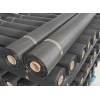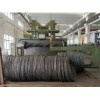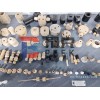International trade
International trade is the exchange of capital, goods, and services across international borders or territories.[1]In most countries, such trade represents a significant share of gross domestic product (GDP). While internationaltrade has been present throughout much of history (see Silk Road, Amber Road), its economic, social, and political importance has been on the rise in recent centuries. It is the presupposition of international trade that a sufficient level of geopolitical peace and stability are prevailing in order to allow for the peaceful exchange of trade and commerce to take place between nations.
Trading globally gives consumers and countries the opportunity to be exposed to goods and services not available in their own countries. Almost every kind of product can be found on the international market: food, clothes, spare parts, oil, jewelry, wine, stocks, currencies and water. Services are also traded: tourism, banking, consulting and transportation. A product that is sold to the global market is an export, and a product that is bought from the global market is an import. imports and exports are accounted for in a country's current account in the balance of payments. [2]
In most countries, such trade represents a significant share of gross domestic product (GDP). While internationaltrade has been present throughout much of history (see Silk Road, Amber Road), its economic, social, and political importance has been on the rise in recent centuries. It is the presupposition of international trade that a sufficient level of geopolitical peace and stability are prevailing in order to allow for the peaceful exchange of trade and commerce to take place between nations.
Ancient Silk Road trade routes across Eurasia
Industrialization, advanced technology transportation, globalization, multinational corporations, and outsourcing are all having a major impact on the international trade system. Increasing international trade is crucial to the continuance of globalization. Without international trade, nations would be limited to the goods and services produced within their own borders. International trade is, in principle, not different from domestic trade as the motivation and the behavior of parties involved in a trade do not change fundamentally regardless of whether trade is across a border or not. The main difference is that international trade is typically more costly than domestic trade. The reason is that a border typically imposes additional costs such as tariffs, time costs due to border delays and costs associated with country differences such as language, the legal system or culture.
Another difference between domestic and international trade is that factors of production such as capital and labor are typically more mobile within a country than across countries. Thus international trade is mostly restricted to trade in goods and services, and only to a lesser extent to trade in capital, labor or other factors of production. Trade in goods and services can serve as a substitute for trade in factors of production. Instead of importing a factor of production, a country can import goods that make intensive use of that factor of production and thus embody it. An example is the import of labor-intensive goods by the United States from China. Instead of importing Chinese labor, the United States imports goods that were produced with Chinese labor. One report in 2010 suggested that international trade was increased when a country hosted a network of immigrants, but the trade effect was weakened when the immigrants became assimilated into their new country.[3]
International trade is also a branch of economics, which, together with international finance, forms the larger branch calledinternational economics. Trading is a value-added function: it is the economic process by which a product finds its market, in which specific risks are to be borne by the trader.
Contents
[hide]
• 1 History
• 2 Models
o 2.1 Adam Smith's model
o 2.2 Ricardian model
o 2.3 Heckscher–Ohlin model
2.3.1 Applicability
o 2.4 New Trade Theory
o 2.5 Gravity model
o 2.6 Ricardian theory of international trade (modern development)
2.6.1 Contemporary theories
2.6.2 Neo-Ricardian trade theory
2.6.3 Traded intermediate goods
2.6.4 Ricardo-Sraffa trade theory
2.6.5 International Production Fragmentation Trade Theory
• 3 Largest countries by total international trade
• 4 Top traded commodities (exports)
• 5 See also
• 6 Notes
• 7 References
• 8 External links
o 8.1 Data
8.1.1 Official statistics
8.1.2 Other data sources
o 8.2 Other external links
History[edit]
Roman trade with India according to thePeriplus Maris Erythraei, 1st century CE.
Main article: Timeline of international trade
The history of international trade chronicles notable events that have affected the trade between various countries.
In the era before the rise of the nation state, the term 'international' trade cannot be literally applied, but simply means trade over long distances; the sort of movement in goods which would represent international trade in the modern world.
Models[edit]
The following are noted models of international trade.[4]
Adam Smith's model[edit]
Adam Smith displays trade taking place on the basis of countries exercising absolute advantage over one another.[5][6]
Ricardian model[edit]
The law of comparative advantage was first proposed by David Ricardo.
The Ricardian model focuses on comparative advantage, which arises due to differences in technology or natural resources. The Ricardian model does not directly consider factor endowments, such as the relative amounts of labor and capital within a country.
The Ricardian model is based on the following assumptions:
• Labor is the only primary input to production
• The relative ratios of labor at which the production of one good can be traded off for another differ between countries and governments
Heckscher–Ohlin model[edit]
Main article: Heckscher–Ohlin model
In the early 1900s a theory of international trade was developed by two Swedish economists, Eli Heckscher and Bertil Ohlin. This theory has subsequently been known as the Heckscher–Ohlin model (H–O model). The results of the H–O model are that countries will produce and export goods that require resources (factors) which are relatively abundant and import goods that require resources which are in relative short supply.
In the Heckscher–Ohlin model the pattern of international trade is determined by differences in factor endowments. It predicts that countries will export thosegoods that make intensive use of locally abundant factors and will import goods that make intensive use of factors that are locally scarce. Empirical problems with the H–O model, such as the Leontief paradox, were noted in empirical tests by Wassily Leontief who found that the United States tended to export labor-intensive goods despite having an abundance of capital.
The H–O model makes the following core assumptions:
• Labor and capital flow freely between sectors
• The amount of labor and capital in two countries differ (difference in endowments)
• Technology is the same among countries (a long-term assumption)
• Tastes are the same
Applicability[edit]
In 1953, Wassily Leontief published a study in which he tested the validity of the Heckscher-Ohlin theory.[7] The study showed that the United States was more abundant in capital compared to other countries, therefore the United States would export capital-intensive goods and import labor-intensive goods. Leontief found out that the United States' exports were less capital intensive than its imports.
After the appearance of Leontief's paradox, many researchers tried to save the Heckscher-Ohlin theory, either by new methods of measurement, or by new interpretations. Leamer[8] emphasized that Leontief did not interpret H-O theory properly and claimed that with a right interpretation, the paradox did not occur. Brecher and Choudri[9] found that, if Leamer was right, the American workers' consumption per head should be lower than the workers' world average consumption.[10][11] Many textbook writers, including Krugman and Obstfeld and Bowen, Hollander and Viane, are negative about the validity of H-O model.[12][13]After examining the long history of empirical research, Bowen, Hollander and Viane concluded: "Recent tests of the factor abundance theory [H-O theory and its developed form into many-commodity and many-factor case] that directly examine the H-O-V equations also indicate the rejection of the theory."[13]:321
In the specific factors model, labor mobility among industries is possible while capital is assumed to be immobile in the short run. Thus, this model can be interpreted as a short-run version of the Heckscher-Ohlin model. The "specific factors" name refers to the assumption that in the short run, specific factors of production such as physical capital are not easily transferable between industries. The theory suggests that if there is an increase in the price of a good, the owners of the factor of production specific to that good will profit in real terms.
Additionally, owners of opposing specific factors of production (i.e., labor and capital) are likely to have opposing agendas when lobbying for controls over immigration of labor. Conversely, both owners of capital and labor profit in real terms from an increase in the capital endowment. This model is ideal for understanding income distribution but awkward for discussing the pattern of trade.
New Trade Theory[edit]
Main article: New Trade Theory
New Trade Theory tries to explain empirical elements of trade that comparative advantage-based models above have difficulty with. These include the fact that most trade is between countries with similar factor endowment and productivity levels, and the large amount of multinational production (i.e., foreign direct investment) that exists. New Trade theories are often based on assumptions such as monopolistic competition and increasing returns to scale. One result of these theories is the home-market effect, which asserts that, if an industry tends to cluster in one location because of returns to scale and if that industry faces high transportation costs, the industry will be located in the country with most of its demand, in order to minimize cost.
Although new trade theory can explain the growing trend of trade volumes of intermediate goods, Krugman's explanation depends too much on the strict assumption that all firms are symmetrical, meaning that they all have the same production coefficients. Shiozawa, based on much more general model, succeeded in giving a new explanation on why the traded volume increases for intermediate goods when the transport cost decreases.[14]
Gravity model[edit]
Main article: Gravity model of trade
The Gravity model of trade presents a more empirical analysis of trading patterns. The gravity model, in its basic form, predicts trade based on the distance between countries and the interaction of the countries' economic sizes. The model mimics the Newtonian law of gravity which also considers distance and physical size between two objects. The model has been proven to be empirically strong through econometric analysis.
Ricardian theory of international trade (modern development)[edit]
The Ricardian theory of comparative advantage became a basic constituent of neoclassical trade theory. Any undergraduate course in trade theory includes a presentation of Ricardo's example of a two-commodity, two-country model. A common representation of this model is made using an Edgeworth Box.
This model has been expanded to many-country and many-commodity cases. Major general results were obtained by McKenzie[15][16] and Jones,[17] including his famous formula. It is a theorem about the possible trade pattern for N-country N-commodity cases.
Contemporary theories[edit]
Ricardo's idea was even expanded to the case of continuum of goods by Dornbusch, Fischer, and Samuelson[18] This formulation is employed for example by Matsuyama[19] and others. These theories use a special property that is applicable only for the two-country case.
Neo-Ricardian trade theory[edit]
Inspired by Piero Sraffa, a new strand of trade theory emerged and was named neo-Ricardian trade theory. The main contributors include Ian Steedman (1941–) and Stanley Metcalfe (1946–). They have criticized neoclassical international trade theory, namely the Heckscher-Ohlin model on the basis that the notion of capital as primary factor has no method of measuring it before the determination of profit rate (thus trapped in a logical vicious circle).[20] This was a second round of the Cambridge capital controversy, this time in the field of international trade.[21]
The merit of neo-Ricardian trade theory is that input goods are explicitly included. This is in accordance with Sraffa's idea that any commodity is a product made by means of commodities. The limitation of their theory is that the analysis is restricted to small-country cases.
Traded intermediate goods[edit]
Ricardian trade theory ordinarily assumes that the labor is the unique input. This is a great deficiency as trade theory, for intermediate goods occupy the major part of the world international trade. Yeats[22] found that 30% of world trade in manufacturing involves intermediate inputs. Bardhan and Jafee[23] found that intermediate inputs occupy 37 to 38% of U.S. imports for the years 1992 and 1997, whereas the percentage of intra-firm trade grew from 43% in 1992 to 52% in 1997.
McKenzie[24] and Jones[25] emphasized the necessity to expand the Ricardian theory to the cases of traded inputs. In a famous comment McKenzie (1954, p. 179) pointed that "A moment's consideration will convince one that Lancashire would be unlikely to produce cotton cloth if the cotton had to be grown in England."[26]Paul Samuelson[27] coined a term Sraffa bonus to name the gains from trade of inputs.
Ricardo-Sraffa trade theory[edit]
Economist John S. Chipman observed in his survey that McKenzie stumbled upon the questions of intermediate products and postulated that "introduction of trade in intermediate product necessitates a fundamental alteration in classical analysis".[28] It took many years until Shiozawa succeeded in removing this deficiency.[29] The Ricardian trade theory was now constructed in a form to include intermediate input trade for the most general case of many countries and many goods. Chipman called this the Ricardo-Sraffa trade theory.
based on an idea of Takahiro Fujimoto,[30] who is a specialist in automobile industry and a philosopher of the international competitiveness, Fujimoto and Shiozawa developed a discussion in which how the factories of the same multi-national firms compete between them across borders.[31] International intra-firm competition reflects a really new aspect of international competition in the age of so-called global competition.
International Production Fragmentation Trade Theory[edit]
Fragmentation and International Trade Theory widens the scope for "application of Ricardian comparative advantage".[32] In his chapter entitled Li & Fung, Ltd.: An agent of global production (2001), Cheng used Li & Fung Ltd as a case study in the international production fragmentation trade theory through which producers in different countries are allocated a specialized slice or segment of the value chain of the global production. Allocations are determined based on "technical feasibility" and the ability to keep the lowest final price possible for each product.[33]
An example of fragmentation theory in international trade is Li and Fung's garment sector network with yarn purchased in South Korea, woven and dyed in Taiwan, the fabric cut in Bangladesh, pieces assembled in Thailand and the final product sold in the United States and Europe to major brands.[34] In 1995 Li & Fung Ltd purchased Inchcape Buying Services, an established British trading company and widely expanded production in Asia.[33] Li & Fung supplies dozens of major retailers, including Wal-Mart Stores, Inc., branded as Walmart.






